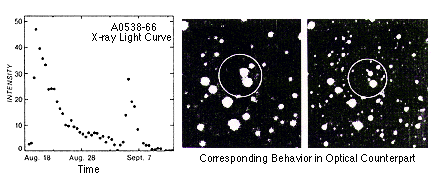Welcome to the World of X-ray Transients!
Introduction to Transient X-ray Sources
The definition of "transient" found in the dictionary reads: passing away with time; not permanent; temporary. Certain cosmic X-ray sources behave in just such a manner. They seem to appear in the sky for a short time and then disappear. Some of them eventually reappear - after years or decades. The class of sources called "transients" was created to distinguish such sources as different from the more permanent, stable sources observed in the X-ray sky. It is important to remember that the object in the sky does not really disappear, just the X-ray emission we see coming from it.
There are many reasons that certain sources have this kind of "now you see me, now you don't" behavior. It is believed that sudden large changes in the accretion rate of the compact object in a binary system lie at the heart of the transient behavior. The reasons why the accretion rate may suddenly change in a big way are clear for some systems (it can be a natural cycle in the behavior of the normal star), but not clear for others. Finding a consistent explanation for the behavior of all the kinds of transient behavior observed is an active area of astronomical research.

Is a Transient Different from a Highly Variable Source?
All stars change their brightness on some timescale - it might be the nuclear evolution timescale (millions to billions of years!) as the star goes through its life, or it might be on a much shorter timescale (less than centuries). For the class of stars which change their brightness on short timescales, there are two subdivisions:
- "extrinsic" variables - which include binary systems in which the apparent brightness is modulated by eclipses due to the binary companion intervening or some intervening nebulosity. Such systems have helped us gain knowledge about fundamental astrophysical parameters such as stellar sizes and masses.
- "intrinsic" variables - which include stars which have flares, pulsations, quasi-periodic expansion/contraction of their stellar envelopes, mass accretion or ejection, explosive thermonuclear burning (novae), and cataclysmic gravitational collapse (supernovae). Such objects have provided us with knowledge of stellar structure, dynamics, and evolution.
Since most of the observed X-rays are generated from the accretion process, the very nature of accretion produces a large degree of variability in the amount of X-rays produced by a given object as a function of time. The timescales can range from milliseconds to years. Some of the variations are regularly spaced in time, such as those due to the rotation period of the compact object in a binary or the revolution period of one star around another. Other modulations might be quasi-periodic, that is they occur "almost" on a regular basis, and can be the result of complicated interactions between the stars and the accretion disk surrounding the compact object. Some variations are completely aperiodic, that is they recur at random times. This might be due to a sudden variation in the stellar wind from the normal star or a sudden mass ejection from the normal star.
The differentiation of objects into separate categories called "highly variable" versus "transient" is somewhat artificial and not always clear cut, although in general, it is believed that distinctly different physical phenomena are responsible for what astronomers have classified as "highly variable" versus "transient" behavior. A good rule of thumb is to refer to sources as "transient" which behave in the following way:
- They have a fairly rapid rise in intensity followed by a gradual decline. Typically, transients reach their maximum intensity in about a week and decline back to undetectability in a month or two.
- The change in intensity is typically a factor of 1000 or more.
- In quiescence, the source in undetectable to a level of 10-12 erg/s/cm2 in the 2-6 keV range.
- The recurrence timescale is years.
Last Modified: December 2006


